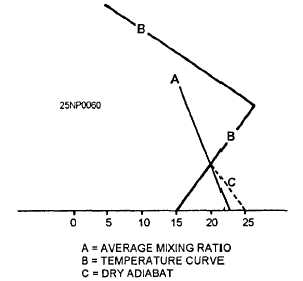When the air temperature is approximately -30°F
or lower, ice fog frequently forms very rapidly in the
exhaust gases of aircraft, automobiles, or other types of
combustion engines.
When there is little or no wind, it is possible for an
aircraft to generate enough ice fog during landing or
takeoff to cover the runway and a portion of the airfield.
Depending on the atmospheric conditions, ice fogs may
persist for periods of a few minutes to several days.
There is also a tine arctic mist of ice crystals that
persists as a haze over wide expanses of the arctic basin
during winter; this fine mist may extend upward through
much of the troposphere, similar to a cirrus cloud with
the base reaching the ground.
USE OF THE SKEW T LOG P DIAGRAM IN
FORECASTING THE FORMATION AND
DISSIPATION OF FOG
One of the most accepted methods for forecasting
the formation and dissipation of fog makes use of an
upper air sounding plotted on the Skew T Log P
Diagram. The plotting of an upper air sounding is useful
in forecasting both the formation and dissipation of fog,
but it can be used more objectively in forecasting fog
dissipation.
The use of an upper air sounding to determine the
possibility of fog formation must be subjective. A study
of the existing lapse rate should be made to determine
the stability or instability of the lower layers. The
surface layer must be stable before fog can form. If it
is not found to be stable, the cooling expected during the
forecast period must be considered, and this
modification should be applied to the sounding to
determine if the layer will be stable with the additional
cooling.
The difference between the temperature and the
dewpoint must be considered. If the air temperature and
the dewpoint are expected to coincide during the period
covered by the forecast, a formation of fog is very likely.
The expected wind speed must be considered. If the
wind speed is expected to be strong, the cooling will not
result in a surface inversion favorable for the formation
of fog, but may result in an inversion above the surface,
which is favorable for the formation of stratus clouds.
DETERMINATION OF FOG HEIGHT
An upper air sounding taken during the time fog is
present will show a surface inversion. The fog will not
necessarily extend to the top of the inversion. If the
temperature and dewpoint have the same value at the
top of the inversion, you can assume that the fog extends
to the top of the inversion. However, if they do not have
the same value, you can determine the depth of the fog
by averaging the mixing ratio at the surface and the
mixing ratio at the top of the inversion. The intersection
of this average mixing ratio with the temperature curve
is the top of the fog layer.
Two methods that may be used to find the height of
the top of the fog layer, in feet, are reading the height
directly from the pressure-height curve on the Skew T
Log P Diagram or by using the dry adiabatic method.
1. In using the pressure-height curve method,
locate the point where the temperature curve and the
average mixing ratio line intersect on the Skew T Log P
Diagram. Move this point horizontally until the
pressure-height curve is intersected. Determine the
height of the fog layer from the value of the
pressure-height curve at this intersection.
2. The dry adiabatic method is based on the fact
that the dry adiabatic lapse rate is 1°C per 100 m, or 1°C
per 328 ft. Using this method, follow the dry adiabat
from the intersection of the average mixing ratio line
with the temperature curve to the surface level. Find the
temperature difference between the point where the dry
adiabat reaches the surface and the point of intersection
of the dry adiabat and the average mixing ratio. For
example, in figure 5-18, the dry adiabat at the surface is
25°C. The temperature at the intersection of the dry
adiabat and the average mixing ratio is 20°C. By
applying the dry adiabatic method with a lapse rate of
1°C per 328 ft, we find the height of the top of the fog
layer as follows:
Figure 5-18.-Dry adiabatic method of determining fog height.
5-25


